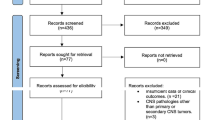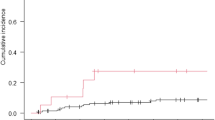Abstract
Glioblastoma multiforme patients presenting with recurrence following multimodality therapy have limited palliative treatment options when the major modalities of therapy including surgery, radiochemotherapy and adjuvant chemotherapy have been exhausted. The authors introduce a clinical and radiological indication-solving algorithm and provide outcome rates of a glioblastoma recurrence cohort. Sixty six consecutive adult patients with recurrent glioblastoma who underwent a combined scheme of salvage treatments consisting of reoperation, high dose rate (HDR) brachytherapy and chemotherapy were included in this prospective study and were compared to a historical control group of 24 recurrent glioblastoma patients who have been treated with intensive temozolomide chemotherapy as the only treatment modality. Median follow-up was 32 months (range 28–36 months). Median survival was 9 months for the entire cohort after salvage treatment and can be translated into a 3-month improvement in survival compared to the control group of patients with glioblastoma recurrence treated with temozolomide alone (P = 0.043). Toxicity and adverse events of reoperation, HDR brachytherapy combined with chemotherapy were quite favourable compared to intensive temomozolomide chemotherapy as the only treatment. Our experience suggests that a combined salvage treatment plan appears to be both feasible and effective and can be considered in selected patients affected by recurrent high grade gliomas. The authors’ clinical and radiological indication-solving algorithm may assist in providing the best possible salvage treatment for this difficult population.


Similar content being viewed by others
Abbreviations
- CTCAE:
-
Common terminology criteria for adverse events
- ddTMZ:
-
Dense dose temozolomide
- FSRS:
-
Fractionated stereotactic radiosurgery
- HDR:
-
High dose rate
- KPS:
-
Karnofsky performance status
References
Affronti ML, Heery CR, Herndon JE 2nd, Rich JN, Reardon DA, Desjardins A et al (2009) Overall survival of newly diagnosed glioblastoma patients receiving carmustine wafers followed by radiation and concurrent temozolomide plus rotational multiagent chemotherapy. Cancer 115:3501–3511
Archavlis E, Tselis N, Birn G, Ulrich P, Baltas D, Zamboglou N (2013) Survival analysis of HDR brachytherapy versus reoperation versus temozolomide alone: a retrospective cohort analysis of recurrent glioblastoma multiforme. BMJ Open 3(3)
Brada M, Baumert B (1999) Focal fractionated conformal stereotactic boost following conventional radiotherapy of high-grade gliomas: a randomized phase III study. A joint study of the EORTC (22972) and the MRC (BR10). Front Radiat Ther Oncol 33:241–243
Wernicke AG, Sherr DL, Schwartz TH, Pannullo SC, Stieg PE, Boockvar JA et al (2010) The role of dose escalation with intracavitary brachytherapy in the treatment of localized CNS malignancies: outcomes and toxicities of a prospective study. Brachytherapy 9:91–99
Kim HK, Thornton AF, Greenberg HS, Page MA, Junck L, Sandler HM (1997) Results of re-irradiation of primary intracranial neoplasms with three-dimensional conformal therapy. Am J Clin Oncol 20:358–363
Fuller CD, Choi M, Forthuber B, Wang SJ, Rajagiriyil N, Salter BJ et al (2007) Standard fractionation intensity modulated radiation therapy (IMRT) of primary and recurrent glioblastoma multiforme. Radiat Oncol 14(2):26
Shaw E, Scott C, Souhami L, Dinapoli R, Bahary JP, Kline R et al (1996) Radiosurgery for the treatment of previously irradiated recurrent primary brain tumors and brain metastases: initial report of radiation therapy oncology group protocol (90-05). Int J Radiat Oncol Biol Phys 34:647–654
Villavicencio AT, Burneikiene S, Romanelli P, Fariselli L, McNeely L, Lipani JD et al (2009) Survival following stereotactic radiosurgery for newly diagnosed and recurrent glioblastoma multiforme: a multicenter experience. Neurosurg Rev 32:417–424
Leibel SA, Gutin PH, Wara WM, Silver PS, Larson DA, Edwards MS et al (1989) Survival and quality of life after interstitial implantation of removable high-activity iodine-125 sources for the treatment of patients with recurrent malignant gliomas. Int J Radiat Oncol Biol Phys 17:1129–1139
Park JK, Hodges T, Arko L, Shen M, Dello Iacono D, McNabb A et al (2010) Scale to predict survival after surgery for recurrent glioblastoma multiforme. J Clin Oncol 28:3838–3843
Quant EC, Drappatz J, Wen PY, Norden AD (2010) Recurrent high-grade glioma. Curr Treat Options Neurol 12:321–333
Scharfen CO, Sneed PK, Wara WM, Larson DA, Phillips TL, Prados MD et al (1992) High activity iodine-125 interstitial implant for gliomas. Int J Radiat Oncol Biol Phys 24:583–591
Trent S, Kong A, Short SC, Traish D, Ashley S, Dowe A et al (2002) Temozolomide as second-line chemotherapy for relapsed gliomas. J Neurooncol 57:247–251
Brem H, Piantadosi S, Burger PC, Walker M, Selker R, Vick NA et al (1995) Placebo-controlled trial of safety and efficacy of intraoperative controlled delivery by biodegradable polymers of chemotherapy for recurrent gliomas.The polymer-brain tumor treatment group. Lancet 345:1008–1012
Gutin PH, Iwamoto FM, Beal K, Mohile NA, Karimi S, Hou BL et al (2009) Safety and efficacy of bevacizumab with hypofractionated stereotactic irradiation for recurrent malignant gliomas. Int J Radiat Oncol Biol Phys 75(1):156–163
Cuneo KC, Vredenburgh JJ, Sampson JH, Reardon DA, Desjardins A, Peters KB et al (2012) Safety and efficacy of stereotactic radiosurgery and adjuvant bevacizumab in patients with recurrent malignant gliomas. Int J Radiat Oncol Biol Phys 82(5):2018–2024
Kolotas C, Birn G, Baltas D, Rogge B, Ulrich P, Zamboglou N (1999) CT guided interstitial high dose rate brachytherapy for recurrent malignant gliomas. Br J Radiol 72:805–808
Tselis N, Kolotas C, Birn G, Röddiger S, Filipowicz I, Kontova M et al (2007) CT-guided interstitial HDR brachytherapy for recurrent glioblastoma multiforme. Long-term results. Strahlenther Onkol 183:563–570
Wick W, Steinbach JP, Küker WM, Dichgans J, Bamberg M, Weller M (2004) One week on/one week off: a novel active regimen of temozolomide for recurrent glioblastoma. Neurology 62:2113–2115
Macdonald DR, Cascino TL, Schold SC Jr, Cairncross JG (1990) Response criteria for phase II studies of supratentorial malignant glioma. J Clin Oncol 8:1277–1280
Aydin H, Sillenberg I, von Lieven H (2001) Patterns of failure following CT-based 3-D irradiation for malignant glioma. Strahlenther Onkol 177:424–431
Chan JL, Lee SW, Fraass BA, Normolle DP, Greenberg HS, Junck LR et al (2002) Survival and failure patterns of high-grade gliomas after three-dimensional conformal radiotherapy. J Clin Oncol 20:1635–1642
Stummer W, Pichlmeier U, Meinel T, Wiestler OD, Zanella F, Reulen HJ, ALA-Glioma Study Group (2006) Fluorescence-guided surgery with 5-aminolevulinic acid for resection of malignant glioma: a randomised controlled multicentre phase III trial. Lancet Oncol 7:392–401
Stummer W, Reulen HJ, Meinel T, Pichlmeier U, Schumacher W, Tonn JC, ALA-Glioma Study Group (2008) Extent of resection and survival in glioblastoma multiforme: identification of and adjustment for bias. Neurosurgery 62:564–576
Barker FG 2nd, Chang SM, Gutin PH, Malec MK, McDermott MW, Prados MD et al (1998) Survival and functional status after resection of recurrent glioblastoma multiforme. Neurosurgery 42:709–720
Dirks P, Bernstein M, Muller PJ, Tucker WS (1993) The value of reoperation for recurrent glioblastoma. Can J Surg 36:271–275
Mayer R, Sminia P (2008) Reirradiation tolerance of the human brain. Int J Radiat Oncol Biol Phys 70(5):1350–1360
Bernstein M, Laperriere N, Glen J, Leung P, Thomason C, Landon AE (1994) Brachytherapy for recurrent malignant astrocytoma. Int J Radiat Oncol Biol Phys 30:1213–1217
Saw CB, Suntharalingam N, Ayyangar KM, Tupchong L (1989) Dosimetric considerations of stereotactic brain implants. Int J Radiat Oncol Biol Phys 17:887–891
Barbarisi M, Romanelli P (2012) The emerging role of stereotactic radiosurgery in the treatment of glioblastoma multiforme. Curr Radiopharm 5:292–299
Fokas E, Wacker U, Gross MW, Henzel M, Encheva E, Engenhart-Cabillic R (2009) Hypofractionated stereotactic reirradiation of recurrent glioblastomas: a beneficial treatment option after high-dose radiotherapy? Strahlenther Onkol 185:235–240
Combs SE, Thilmann C, Edler L, Debus J, Schulz-Ertner D (2005) Efficacy of fractionated stereotactic reirradiation in recurrent gliomas: long-term results in 172 patients treated in a single institution. J Clin Oncol 23:8863–8869
Wick A, Felsberg J, Steinbach JP, Herrlinger U, Platten M, Blaschke B et al (2007) Efficacy and tolerability of temozolomide in an alternating weekly regimen in patients with recurrent glioma. J Clin Oncol 25(22):3357–3361
Norden AD, Lesser GJ, Drappatz J, Ligon KL, Hammond SN, Lee EQ et al (2013) Phase 2 study of dose-intense temozolomide in recurrent glioblastoma. Neuro Oncol 15(7):930–935
Taal W, Segers-van Rijn JM, Kros JM, van Heuvel I, van der Rijt CC, Bromberg JE et al (2012) Dose dense 1 week on/1 week off temozolomide in recurrent glioma: a retrospective study. J Neurooncol 108:195–200
Friedman HS, Prados MD, Wen PY, Mikkelsen T, Schiff D, Abrey LE et al (2009) Bevacizumab alone and in combination with irinotecan in recurrent glioblastoma. J Clin Oncol 27:4733–4740
Gállego Pérez-Larraya J, Lahutte M, Petrirena G, Reyes-Botero G, González-Aguilar A, Houillier C et al (2012) Response assessment in recurrent glioblastoma treated with irinotecan-bevacizumab: comparative analysis of the Macdonald, RECIST, RANO, and RECIST + F criteria. Neuro Oncol 14:667–673
Kreisl TN, Kim L, Moore K, Duic P, Royce C, Stroud I et al (2009) Phase II trial of single-agent bevacizumab followed by bevacizumab plus irinotecan at tumor progression in recurrent glioblastoma. J Clin Oncol 27:740–745
Brada M, Stenning S, Gabe R, Thompson LC, Levy D, Rampling R et al (2010) Temozolomide versus procarbazine, lomustine, and vincristine in recurrent high-grade glioma. J Clin Oncol 28(30):4601–4608
Conflict of interest
The authors report no conflict of interest concerning the materials and methods used in this study or the findings specified in this paper.
Author information
Authors and Affiliations
Corresponding author
Rights and permissions
About this article
Cite this article
Archavlis, E., Tselis, N., Birn, G. et al. Combined salvage therapies for recurrent glioblastoma multiforme: evaluation of an interdisciplinary treatment algorithm. J Neurooncol 119, 387–395 (2014). https://doi.org/10.1007/s11060-014-1500-8
Received:
Accepted:
Published:
Issue Date:
DOI: https://doi.org/10.1007/s11060-014-1500-8




